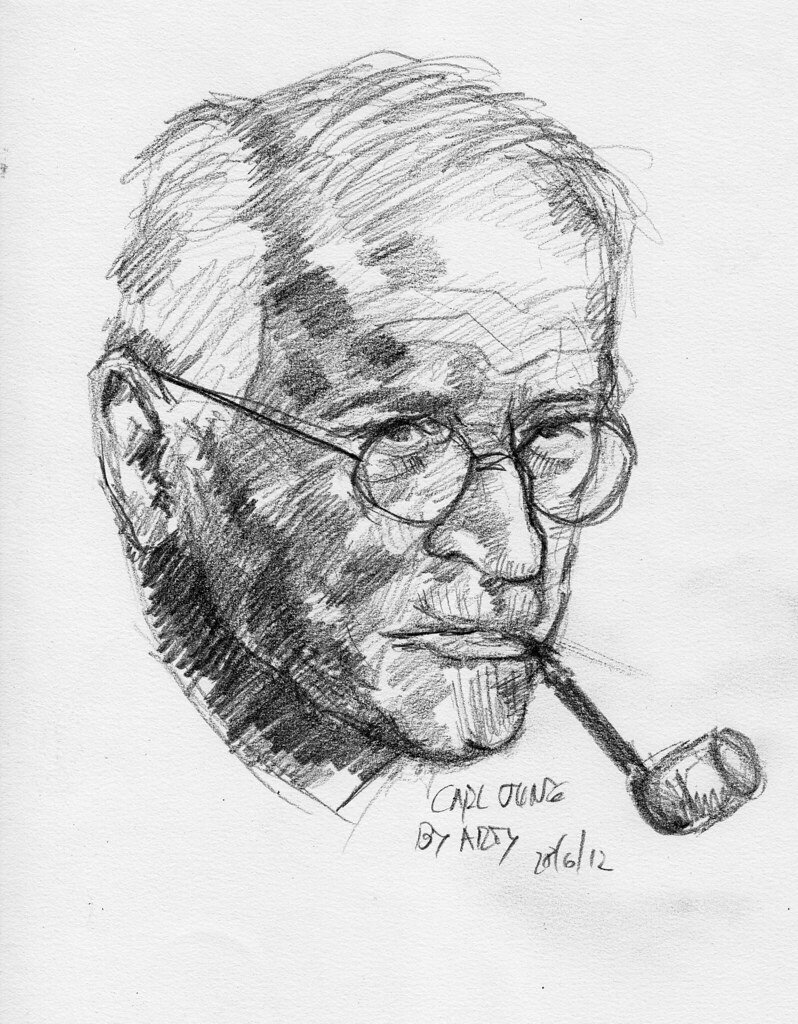
Click below to listen to this article:
Carl Gustav Jung
Carl Jung (1875-1961), was one of the most influential and provocative thinkers of our time. He was a pioneer of analytical psychology who explored the human unconscious and its collective aspects. He introduced concepts such as extroversion and introversion, archetypes, modern dream analysis, and the collective unconscious that have influenced modern psychology, psychiatry, philosophy, literature, art, and culture (Jungian Model of the Psyche, n.d.; How Carl Gustav Jung Influenced Psychology: Dreams to Science, 2021; Biography of Carl Jung: Founder of analytical psychology, 2018).
The life of Jung
Jung was born in a rural village near Lake Constance, Switzerland, to a Protestant pastor father and a mother who claimed to have psychic abilities. He had a lonely and introverted childhood, during which he developed a keen interest in religion, mythology, and philosophy.
He studied medicine at the University of Basel and became interested in psychiatry after reading a book by Richard von Krafft-Ebing. Furthermore, he worked as an assistant to eugen Bleuler at the Burghölzli Psychiatric Clinic in Zurich, where he conducted research on schizophrenia. It was here he met Sigmund Freud and became his became Freud’s protégé and collaborator, but later broke away from him over theoretical and personal differences. He also explored the connections between psychology and various fields such as anthropology, archaeology, literature, religion, alchemy, and astrology.
Jung developed his own theory of the psyche, which he called analytical psychology. He proposed that the psyche consists of three layers: the ego, the personal unconscious, and the collective unconscious. The collective unconscious is a reservoir of inherited images and patterns, called archetypes, that shape human behaviour and culture.
Jung also introduced the concepts of psychological types, individuation, synchronicity, and the transcendent function. Jung travelled extensively and studied various cultures and religions, such as Buddhism, Hinduism, Taoism, alchemy, and gnosticism. He wrote many books and essays on his ideas and founded the C.G. Jung Institute in Zurich. He died in 1961 at his home in Küsnacht.
Jung also proposed a theory of psychological types that suggested that people experience the world using four principal functions – sensation, intuition, feeling, and thinking – and that one of these functions is dominant for most people (Carl Gustav Jung’s Theory of Personality in Psychology, n.d.). Jung’s work was based on his extensive research on various world cultures and his attempt to understand the universal symbols and nature of personality (Jung’s Influence on Contemporary Thought, 1962; Carl Jung – The Balance of Personality, n.d.).
Key influential moments
Jung was involved in some historical events, such as helping an alcoholic patient recover through spiritual guidance, which inspired the creation of Alcoholics Anonymous (Mental Floss, 2018), and meeting with Nazi officials to protect his colleagues and patients during World War II (Wikipedia, n.d.).
Jung’s ideas have inspired many artists, writers, philosophers, and thinkers who have used his concepts to interpret and create works of art, literature, and culture. Some examples are Joseph Campbell, Hermann Hesse, James Joyce, Thomas Mann, J.R.R. Tolkien, George Lucas, and Alan Moore (LOC, 2010).
Bibliography
Some of Jung’s most important works are:
The Psychology of the Unconscious (1912), explores the symbolic meaning and purpose of psychological symptoms, drawing on dreams, mythology, and literature. He proposes that the unconscious mind consists of two layers: the personal unconscious and the collective unconscious. The personal unconscious contains the forgotten or repressed memories and experiences of an individual, while the collective unconscious contains the inherited and universal patterns of the psyche, such as archetypes, instincts, and phobias. Jung argues that psychological problems arise when the conscious and unconscious aspects of the self are not integrated, and that the process of individuation, or becoming a whole person, involves reconciling these opposites through symbols and transformations.
psychological types (1921), explores the differences in human cognition and behaviour based on four main functions of consciousness and two main attitude types. The four functions are Sensation, Intuition, Thinking and Feeling, and they represent the ways that people perceive and judge information. The two attitudes are Extraversion and Introversion, and they indicate the direction of energy flow and interest. Jung proposed that each person has a dominant function and attitude that shape their personality type, but also that all functions and attitudes are present in varying degrees of development. Jung’s theory of psychological types has influenced many fields of psychology, such as personality, clinical, counselling and organizational psychology (McLynn, 1996).
The archetypes and the collective unconscious (1934), a seminal work in psychology that explores the concept of the collective unconscious, which is a layer of the psyche that contains inherited and universal patterns of thought, feeling, and behaviour, known as archetypes (Jung, 1968). Jung argues that these archetypes are expressed in myths, symbols, dreams, and cultural phenomena, and that they shape our individual and collective identities. Jung identifies several major archetypes, such as the anima, the mother, the shadow, the trickster, and the self, and analyses their manifestations in various cultures and historical periods. He also discusses the process of individuation, which is the integration of the conscious and unconscious aspects of the personality, leading to psychological wholeness and harmony. Jung illustrates this process with examples of mandalas, which are circular symbols that represent the self and its relation to the cosmos (Jung, 1968).
Memories, Dreams, Reflections is an autobiography by Carl Jung. The book covers various aspects of Jung’s life, such as his childhood, his personal relationships, his travels, and his exploration of the human psyche. Jung reflects on his dreams, visions, and experiences that shaped his understanding of the unconscious, the collective unconscious, archetypes, symbols, and synchronicity. He also discusses his encounters with different cultures and religions, such as Christianity, Buddhism, Hinduism, Taoism, and alchemy, and how they influenced his views on spirituality and individuation. The book is not a chronological account of Jung’s life, but rather a series of chapters that focus on specific themes or periods of his life. Jung wrote most of the book himself, but some chapters were based on interviews with his colleague and friend Aniela Jaffé (Jung & Jaffé, 1963).
Carl Jung’s The Red Book is a manuscript that documents his psychological experiments and experiences from 1913 to 1916, based on his personal journals known as the Black Books (Jung, 2009). The book is divided into two parts: Liber Primus and Liber Secundus, which contain Jung’s visions, dialogues, fantasies, and reflections on various topics such as the soul, God, the unconscious, mythology, and the modern world. The book reveals how Jung regained his soul and overcame the spiritual alienation of his time by creating a new image of God in his psyche and developing a psychological and theological cosmology (Shamdasani, 2009). The book also contains Jung’s paintings and calligraphy, which illustrate his symbolic and artistic expressions of his inner journey. The Red Book is considered one of the most influential and controversial works in the history of psychology and culture, as it challenges conventional notions of science, religion, and art (Hoeller, 2010).
Jung’s work has been influential in many fields of study and has inspired many scholars and practitioners.
References
Bair, D. (2003). Jung: A biography. Boston: Little, Brown.
Biography of Carl Jung: Founder of analytical psychology. (2018, June 11). ThoughtCo. Retrieved December 12, 2023, from https://www.thoughtco.com/biography-of-carl-jung-4164462
Britannica. (2021). Carl Jung | Biography, archetypes, Books, collective unconscious … Retrieved from https://www.britannica.com/biography/Carl-Jung
Carl Jung Resources. (n.d.). Carl Jung – Bibliography. Retrieved from http://carl-jung.net/bibliography.html
Carl Jung – The Balance of Personality. (n.d.). The Balance of Personality. Retrieved December 12, 2023, from https://pdx.pressbooks.pub/thebalanceofpersonality/chapter/chapter-5-carl-jung/
Carl Gustav Jung’s Theory of Personality in Psychology. (n.d.). Simply Psychology. Retrieved December 12, 2023, from https://www.simplypsychology.org/carl-jung.html
Hoeller, S. A. (2010). The Gnostic Jung and the seven sermons to the dead. Quest Books.
How Carl Gustav Jung Influenced Psychology: Dreams to Science. (2021, September 23). CBT cognitive Behavioral Therapy. Retrieved December 12, 2023, from https://www.cbtcognitivebehavioraltherapy.com/who-is-carl-gustav-jung/
Jung, C. G. (2009). The Red Book: Liber Novus. (S. Shamdasani, Ed. & Trans.). W.W. Norton & Company.
Jung, C. G. (1980). The archetypes and the collective unconscious (R.F.C. Hull, Trans.). Princeton, NJ: Princeton University Press. (Original work published 1959)
Jung, C. G. (2023). Psychology of the Unconscious: A Study of the Transformations and Symbolisms of the Libido (B. M. Hinkle, Trans.). Princeton University Press. (Original work published 1916)
Jung, C. G. (1971). psychological types (H. G. Baynes, Trans.; R. F. C. Hull, Rev.). Princeton University Press. (Original work published 1923)
Jung, C. G., & Jaffé, A. (1963). Memories, dreams, reflections. Pantheon Books.
Jung, C. G. (1968). The archetypes and the collective unconscious (R. F. C. Hull, Trans.). Princeton University Press. (Original work published 1959)
Jungian theory and therapy. (2008). In R.J. Corsini & D. Wedding (Eds.), Current psychotherapies (9th ed., pp. 101-133). Belmont, CA: Thomson Brooks/Cole.
Jungian Model of the Psyche. (n.d.). Journal Psyche. Retrieved December 12, 2023, from https://journalpsyche.org/jungian-model-psyche/
Jung’s Influence on Contemporary Thought. (1962). Spring: A Journal of archetype and Culture, 1(1), 5-14. Retrieved December 12, 2023, from https://www.jstor.org/stable/27504500
LOC. (2010). The Red Book of Carl G. Jung: Its origins and influence. Library of Congress. https://www.loc.gov/exhibits/red-book-of-carl-jung/jungs-cultural-legacy.html
McLynn, F. (1996). Carl Gustav Jung: A biography. Bantam Books.
Mental Floss. (2018). 8 Facts About Carl Jung | Mental Floss. Retrieved December 12, 2023, from https://www.mentalfloss.com/article/561675/carl-jung-facts
Shamdasani, S. (2009). Introduction. In C. G. Jung, The Red Book: Liber Novus (pp. 1-58). W.W. Norton & Company.
Sharp, D. (1954). An introduction to Jung’s psychology. London: Routledge & Kegan Paul.
The SAP. (2021). Carl Jung | Biography, Archetypes & Beliefs | The SAP. Retrieved from https://www.thesap.org.uk/articles-on-jungian-psychology-2/carl-gustav-jung/
ThoughtCo. (2021). Biography of Carl Jung: Founder of analytical psychology – ThoughtCo. Retrieved from https://www.thoughtco.com/biography-of-carl-jung-4164462
Wikipedia. (2021). Carl Jung – Wikipedia. Retrieved from https://en.wikipedia.org/wiki/Carl_Jung




0 Comments